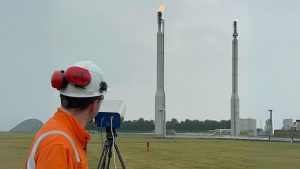In the dynamic landscape of the oil and gas industry, the practice of flaring has emerged as a critical focal point in discussions around environmental stewardship and operational efficiency. Flare measurement, the process of quantifying the gas combusted in flare systems, plays a pivotal role in minimizing the environmental footprint of natural gas extraction and processing operations. This article delves into the complex science behind flare measurement, exploring how advancements in technology and regulation are helping to balance the twin imperatives of efficiency and environmental responsibility.
Understanding Flare Measurement
Flaring, a controlled process of burning excess natural gas during oil and gas production, is a necessary practice for safety and environmental protection. However, its impact on the environment, particularly in terms of carbon emissions, has necessitated the development of more efficient and less environmentally damaging approaches.
The Importance of Accurate Flare Measurement
Accurate flare measurement is essential for understanding and reducing the environmental impact of flaring. It enables operators to optimize flare systems, ensuring that only necessary gases are flared, thereby reducing emissions. Advanced technologies, including infrared imaging and remote sensing, have significantly improved the accuracy of flare measurements, offering real-time data that can guide operational adjustments.
Challenges in Flare Measurement
Despite technological advancements, flare measurement faces challenges such as variable flare compositions and the influence of external environmental factors. These challenges complicate the accurate assessment of combustion efficiency and the quantification of emissions, requiring continuous innovation and adaptation in measurement technologies.

Balancing Efficiency and Environmental Stewardship
The oil and gas industry is under increasing pressure to demonstrate environmental responsibility without compromising operational efficiency. Achieving this balance requires a comprehensive approach, integrating advanced measurement technologies with strategic flare management practices.
Technological Innovations in Flare Management
Recent innovations, including IoT-enabled devices and real-time monitoring systems, have opened new avenues for improving flare efficiency. These technologies allow for the precise control of flare operations, minimizing unnecessary flaring and reducing emissions. Data analytics plays a crucial role in this process, analyzing vast amounts of data to identify opportunities for optimization and environmental improvement.
Case Studies: Success Stories in Flare Management
Several oil and gas companies have successfully implemented advanced flare measurement and management strategies, significantly reducing their environmental impact. These case studies not only demonstrate the feasibility of achieving more sustainable operations but also serve as a blueprint for others in the industry.
The Role of Regulation and Policy
Regulatory frameworks are critical in driving improvements in flare management. By setting standards and benchmarks for emissions, governments and international bodies can incentivize the adoption of best practices and technologies.

Global Initiatives and Standards
Initiatives such as the World Bank’s “Zero Routine Flaring by 2030” aim to eliminate or significantly reduce flaring, encouraging the industry to adopt more sustainable practices. Compliance with such standards not only benefits the environment but also enhances the social and economic sustainability of oil and gas operations.
Future Directions in Flare Measurement and Environmental Stewardship
As environmental standards continue to evolve, the industry faces the challenge of adapting its practices to meet these new benchmarks. Innovations in flare measurement and management technologies will be crucial in this ongoing effort.
Innovations on the Horizon
Emerging technologies, including advanced sensors, AI-driven analytics, and blockchain for emissions tracking, hold promise for the future of flare management. These innovations could further enhance the accuracy of measurements and the efficiency of operations, leading to significant environmental and economic benefits.
Conclusion
The science of flare measurement is at the heart of the oil and gas industry’s efforts to balance operational efficiency with environmental stewardship. Through continuous innovation in technology and practices, along with adherence to regulatory standards, the industry can achieve significant reductions in emissions and make strides towards more sustainable operations. As we look to the future, the commitment to environmental stewardship will remain a key driver of progress in flare management, reflecting the industry’s evolving relationship with the planet.






